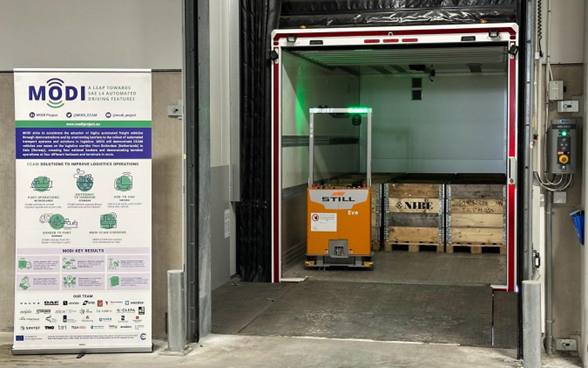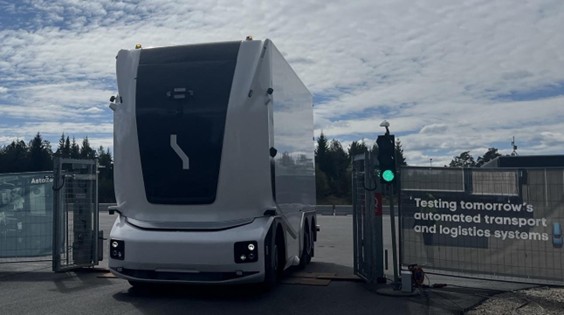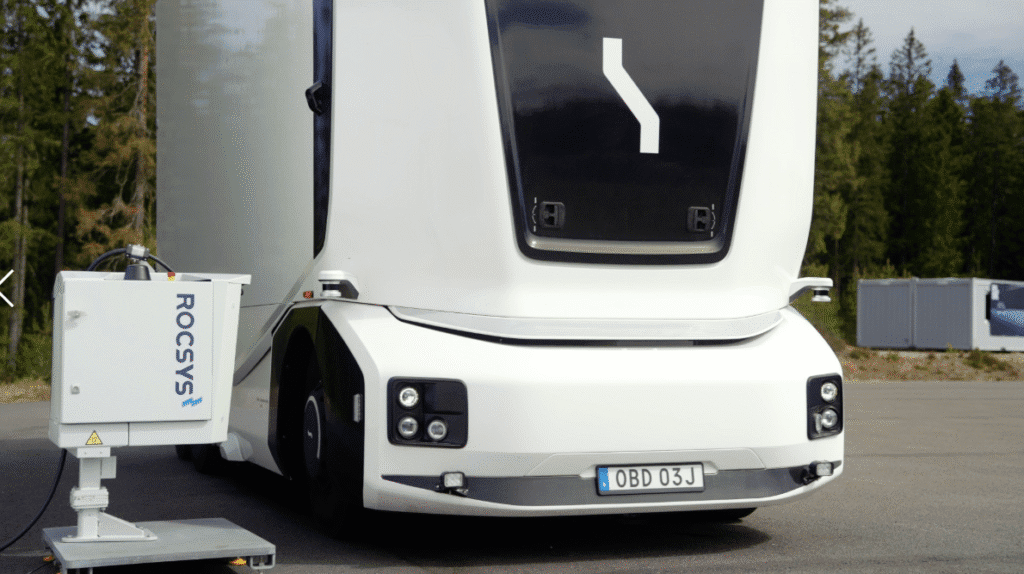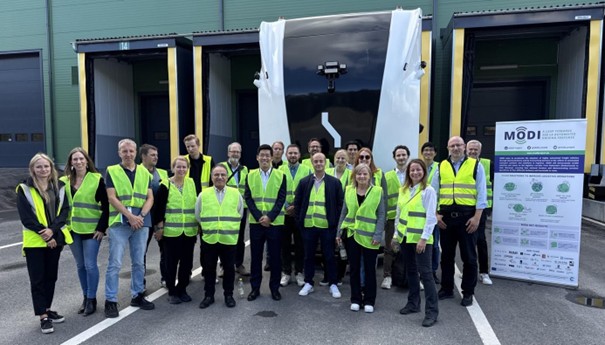The Swedish use case has achieved significant milestones over the past six months. In collaboration with project partners and technology providers, it has demonstrated how automation can transform logistics—safely, sustainably, and at scale.
In September, Einride successfully showcased a cableless, electric, autonomous truck operating on a public road for Apotea, Sweden’s leading online pharmacy. Earlier in the spring, Q-Free, Rocsys, and STILL demonstrated how their innovative technologies can support the transition to fully automated transport systems.
These real-world demonstrations support MODI’s overarching ambition to accelerate the adoption of Connected, Cooperative, and Automated Mobility (CCAM) solutions for logistics by actively addressing implementation barriers through practical testing.
A Real Logistics Flow—Fully Automated
Through individual demonstrations this year, Einride, together with technology partners, has demonstrated an end-to-end automation ecosystem, bringing partners together to deliver a seamless logistics operation. This includes:
Autonomous loading and unloading with STILL’s Self-Driving Vehicle (SDV)
In April, Einride demonstrated how loading and unloading its autonomous heavy-duty vehicles can be performed without a human present, under remote operator supervision. The demonstration partner, STILL, provides autonomous forklifts capable of safely loading and unloading EU pallets. The system can make its own decisions in a trailer and determine its load or unload sequence. By adopting autonomous loading and unloading, benefits are expected in areas such as cost, safety, and efficiency.

Access control systems automated by Q-Free using C-ITS standards
In May, Einride, together with the project partner Q-Free, demonstrated how C-ITS messages can be used for access control to confined areas. Einride used Q-Free’s modular connected vehicle solutions – including both hardware and software services – resulting in a more standardised concept for access control to confined areas. The demonstration applied the EU C-ITS certificate policy to add cybersecurity to the gate access system, thereby avoiding the challenges of relying solely on camera assessment of licence plates. By adopting standardized protocols such as C-ITS, interoperability and scalability can be improved, allowing for a more efficient rollout of automated vehicles and C-ITS solutions across Europe.

Hands-free charging enabled by Rocsys
In May, Einride also demonstrated how charging of its electric autonomous heavy-duty vehicle can remove the need for manual intervention for charging. The demonstration partner, Rocsys, is the leading provider of hands-free charging systems for electric and self-driving vehicles. Its comprehensive, integrated solution combines next-generation soft robotics, advanced computer vision, and data-driven services with intelligent software and proactive support to enable truly hands-free charging for autonomous EVs. The demonstration showcased a solution that makes it possible to deploy autonomous vehicles already today, utilizing existing infrastructure.

A key innovation showcased was the role of the remote operator, who supervises and supports autonomous vehicle operation. This human-machine interaction model ensures safety while enabling scalability.
Event Highlights and Partner Contributions
The event opened with welcoming remarks from Ted Kruse and Maria Backlund (Lindholmen Science Park), setting the stage with an overview of MODI and Sweden’s leadership in smart mobility innovation.
Zeljko Jeftic (Einride) shared a vision for the future of automated logistics, followed by Pia Wijk (Einride), who offered reflections and learnings from the MODI demonstrations in Sweden.
The partner session featured:
- Yasmina Djedou (Apotea), who shared how automation supports more efficient and sustainable e-commerce logistics.
- Johan Thörnberg and Daniel Lindholm (STILL), who presented their Self-Driving Vehicle (SDV) and its role in enabling autonomous loading and unloading, a critical component of warehouse automation.
- The guests were invited to follow the goods from loading in the warehouse to unloading at the distribution center, transported in between by the Einride autonomous electric vehicle.
The day was finalized with a visit to Rosersberg, where Caroline Forsberg (Einride) presented the company’s Smart Charging Station, showcasing the infrastructure and software required to power electrified and autonomous freight systems.
Summary
Einride’s demonstrations within the Swedish use case have provided valuable insights into the technical, operational, and organizational aspects of deploying automated logistics solutions. The demonstrations have highlighted both the potential and the challenges of automation, emphasizing the need for holistic design, strong partnerships, regulatory engagement, and continuous improvement to achieve scalable, efficient, and safe autonomous logistics operations. The learnings from these demonstrations will guide future developments and contribute to the broader adoption of automated mobility in logistics.

